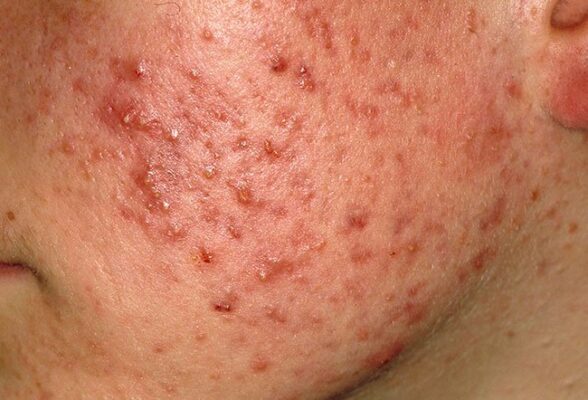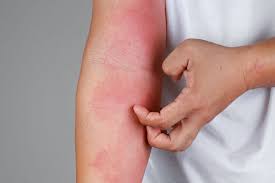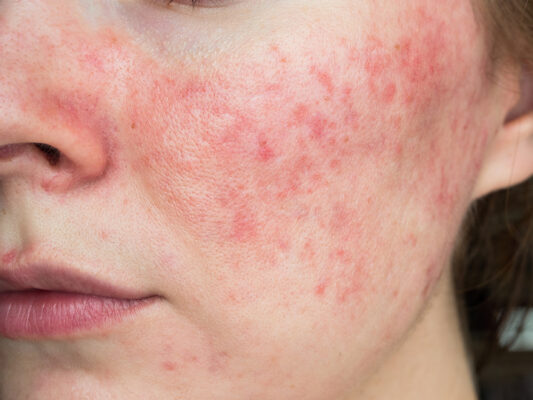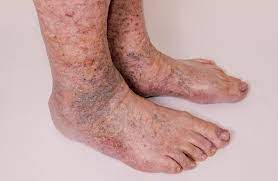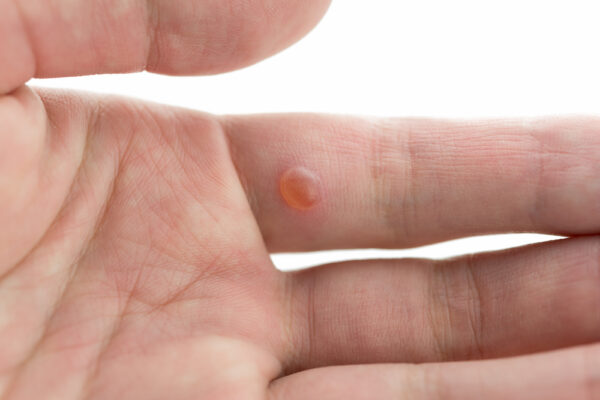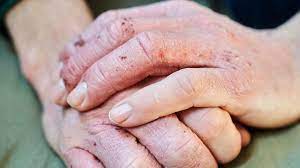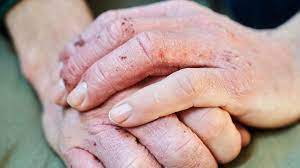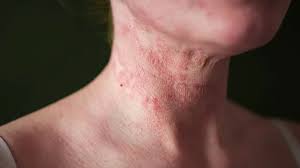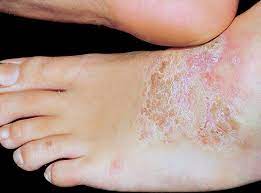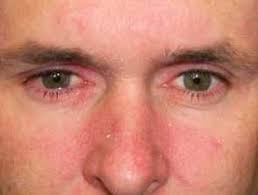Skin diseases are conditions that affect the skin, the largest organ of the body. They can be caused by a variety of factors, including infections, allergies, genetics, environmental factors, and autoimmune disorders. Some common skin diseases include:
Acne: A common skin condition that affects the hair follicles and oil glands, causing pimples and other blemishes
Eczema: A chronic skin condition characterized by inflammation, itching, and redness
Psoriasis: A chronic autoimmune disease that causes thick, scaly patches on the skin
Rosacea: A chronic skin condition that causes redness and swelling on the face
Dermatitis: A general term for inflammation of the skin, which can be caused by a variety of factors, including allergies, irritants, and infections
Warts: Small, rough growths on the skin caused by the human papillomavirus (HPV)
Ringworm: A fungal infection that causes a circular rash on the skin
Shingles: A viral infection that causes a painful rash on one side of the body
Hives: An allergic reaction that causes raised, red, and itchy bumps on the skin
Skin cancer: A type of cancer that develops in the skin, usually as a result of excessive sun exposure
Disease: Acne
Introduction:

Acne is a common skin condition that occurs when hair follicles become clogged with oil and dead skin cells. It can appear as pimples, blackheads, whiteheads, or cysts and can occur on the face, neck, chest, back, and shoulders.
Some of the causes of acne include hormonal changes, stress, genetics, and certain medications. While acne is most commonly associated with teenagers, it can affect people of all ages.
There are several treatments available for acne, including topical medications (such as benzoyl peroxide, salicylic acid, and retinoids), oral medications (such as antibiotics or hormonal therapy), and certain cosmetic procedures (such as chemical peels or laser therapy).
In addition to medical treatments, there are also several lifestyle changes that can help manage acne, such as keeping the skin clean, avoiding picking or squeezing pimples, avoiding excessive sun exposure, and reducing stress. A dermatologist can provide a personalized treatment plan based on the severity and type of acne.
Treatments For Acne:
There are several treatments available for acne, including:
- Topical medications: Over-the-counter creams, gels, and lotions that contain ingredients such as benzoyl peroxide, salicylic acid, and retinoids can be effective in treating mild to moderate acne
- Oral medications: Antibiotics or hormonal therapy (such as birth control pills) may be prescribed by a dermatologist to help control acne that is more severe or resistant to topical treatments
- Chemical peels: A chemical solution is applied to the skin to exfoliate the top layer, which can help improve the appearance of acne and acne scars
- Laser therapy: Certain types of laser treatments can be used to kill bacteria and reduce inflammation associated with acne
- Extraction: A dermatologist or esthetician can manually remove blackheads and whiteheads to improve the appearance of acne
- Lifestyle changes: Simple changes such as keeping the skin clean, avoiding picking or squeezing pimples, reducing stress, and avoiding excessive sun exposure can help manage acne
It’s important to consult with a dermatologist to determine the most appropriate treatment plan for your individual needs and skin type. Treatment may involve a combination of medications and lifestyle changes for the best results.
Tests and Procedures used to diagnose acne:
Acne is usually diagnosed based on a physical examination of the skin by a healthcare professional or dermatologist. There are no specific laboratory tests or procedures used to diagnose acne, but some additional tests may be recommended in certain cases. These may include:
- Skin biopsy: A small sample of skin may be taken and examined under a microscope to rule out other conditions that may resemble acne, such as rosacea or folliculitis
- Hormonal testing: Blood tests may be done to check for hormonal imbalances that can contribute to acne, particularly in women
- Allergy testing: Patch testing may be recommended to identify any allergic triggers that may be exacerbating the acne
- Microbial testing: If the acne is severe or doesn’t respond to initial treatments, a sample of skin may be taken and tested for bacterial or fungal infections that could be contributing to the acne
While additional tests may be recommended in certain cases, the diagnosis of acne is typically made based on the physical appearance of the skin and a review of the patient’s medical history. Treatment can then be tailored to the individual’s needs and severity of the acne.
Procedure For Laser Therapy:
Laser therapy is a non-invasive cosmetic procedure that can be used to treat acne by targeting the sebaceous glands in the skin, which produce oil that can contribute to acne formation. The procedure involves the following steps:

- Preparation: Before the procedure, the patient’s skin is thoroughly cleaned and any makeup or creams are removed
- Eye protection: The patient is provided with protective eyewear to shield their eyes from the laser light
- Laser application: A dermatologist or licensed aesthetician will use a handheld device to direct a focused beam of light at the areas of the skin affected by acne. Laser light is absorbed by the sebaceous glands, causing them to shrink and produce less oil
- Cooling: A cooling device may be used during the procedure to help minimize discomfort and protect the skin from damage
- Post-procedure care: After the laser treatment, the skin may be slightly red or swollen, but this typically subsides within a few hours. Patients should avoid direct sun exposure and apply sunscreen as directed by their dermatologist
The number of laser treatments needed will depend on the severity of the acne and the individual’s skin type. Most patients require multiple sessions spaced several weeks apart to achieve optimal results. Laser therapy is generally considered safe and effective, but it may not be suitable for all patients. A consultation with a dermatologist can help determine if laser therapy is an appropriate treatment option for an individual’s acne.
Procedure For Extraction:
Extraction is a procedure commonly performed by dermatologists or licensed estheticians to remove blackheads and whiteheads from the skin. The procedure involves the following steps:

- Preparation: The skin is cleansed and any makeup or creams are removed
- Softening: A warm, moist towel or steam may be applied to the skin to help soften the pores and make it easier to extract the impurities
- Extraction: Using a sterile, handheld metal extractor tool, the dermatologist or esthetician applies gentle pressure around the pore to remove the blackhead or whitehead. This should not be done by the patient themselves at home, as this can lead to scarring and further breakouts
- Post-procedure care: After the extraction, the skin may be slightly red or swollen, but this typically subsides within a few hours. The dermatologist or esthetician may apply a soothing cream or mask to calm the skin and reduce inflammation
It is important to note that extraction should only be performed by a trained professional, as improper technique can lead to scarring and further damage to the skin.
It is also important to avoid picking or squeezing pimples at home, as this can also lead to scarring and further breakouts. A dermatologist can provide guidance on the best treatment options for an individual’s acne, which may include a combination of extraction, topical medications, and lifestyle changes.
Disease: Eczema
Introduction:

Eczema, also known as atopic dermatitis, is a chronic skin condition characterized by dry, itchy, and inflamed skin. It is a common condition that can affect individuals of all ages, but it often begins in childhood and may persist into adulthood. Eczema can be caused by a combination of genetic and environmental factors, including:
- Family history of eczema, asthma, or allergies
- Dry skin
- Irritants, such as soaps, detergents, and perfumes
- Allergens, such as dust mites, pet dander, and pollen
- Stress
- Changes in temperature or humidity
The symptoms of eczema may vary depending on the individual and the severity of the condition, but can include:
- Dry, itchy skin
- Red or inflamed patches of skin
- Thick, scaly patches of skin
- Small bumps that may ooze or crust over
- Dark or discolored patches of skin
- Itchy blisters on the hands or feet
Treatments for eczema may include:
- Moisturizers: Keeping the skin well-hydrated with regular application of moisturizing creams or ointments can help reduce the itching and dryness associated with eczema
- Topical medications: Steroid creams or ointments, as well as nonsteroidal creams or ointments, can be applied to the affected areas to reduce inflammation and itching
- Oral medications: In severe cases, oral medications such as corticosteroids or immunosuppressants may be prescribed by a dermatologist to help control symptoms
- Lifestyle changes: Avoiding triggers such as harsh soaps, allergens, and stress, as well as maintaining a healthy diet and regular exercise routine, can help reduce the frequency and severity of eczema outbreaks
It is important to consult with a dermatologist to determine the most appropriate treatment plan for an individual’s eczema, as treatment may need to be adjusted over time depending on the severity and response to treatment.
Procedure for Moisturizers:
Moisturizers are an essential part of the treatment for eczema, as they help to keep the skin hydrated and reduce dryness and itching. The following is a general procedure for using moisturizers for eczema:

- Choose the right moisturizer: Look for a moisturizer that is specifically designed for sensitive skin and does not contain fragrances or other potential irritants. Creams and ointments tend to be more effective for eczema than lotions, as they provide a thicker barrier to lock in moisture
- Apply moisturizer regularly: Apply moisturizer to the affected areas of skin at least twice a day, or more frequently as needed. Apply immediately after bathing or showering while the skin is still damp, as this will help to lock in moisture
- Use a generous amount: Apply a generous amount of moisturizer to the affected areas, making sure to cover the entire area thoroughly. Rub the moisturizer in gently until it is absorbed into the skin
- Reapply as needed: Reapply moisturizer throughout the day as needed, especially if the skin feels dry or itchy
- Be consistent: Consistency is key when it comes to using moisturizers for eczema. Make moisturizing a regular part of your daily routine to help keep the skin hydrated and reduce the frequency and severity of eczema outbreaks
It is important to choose a moisturizer that works well for your skin type and to avoid any ingredients that may trigger an allergic reaction or irritate the skin. Consulting with a dermatologist can help you determine the best moisturizer and overall treatment plan for your eczema.
Tests And Procedure Used to diagnose eczema:
Eczema is usually diagnosed based on the appearance of the skin and a patient’s medical history. In some cases, additional tests may be needed to help rule out other skin conditions or identify potential triggers for eczema outbreaks. The following tests and procedures may be used to diagnose eczema:
- Skin examination: A dermatologist or healthcare provider will examine the affected areas of skin, looking for signs of redness, scaling, and itching
- Patch testing: Patch testing may be performed to identify potential allergens or irritants that may be contributing to eczema outbreaks. During this test, small patches containing common allergens are applied to the skin and monitored for any signs of irritation or allergic reaction
- Skin biopsy: A skin biopsy may be performed to help rule out other skin conditions that may mimic the symptoms of eczema. During this procedure, a small sample of skin is taken and examined under a microscope to look for signs of inflammation or infection
- Blood tests: Blood tests may be performed to help identify potential triggers for eczema outbreaks, such as food allergies or autoimmune disorders
While these tests can be helpful in diagnosing eczema and identifying potential triggers for outbreaks, they are not always necessary. In many cases, a dermatologist or healthcare provider can diagnose eczema based on the appearance of the skin and a patient’s medical history.
Disease: Psoriasis
Introduction:

Psoriasis is a chronic autoimmune disorder that affects the skin, causing red, scaly patches that can be itchy and painful. While the exact cause of psoriasis is not fully understood, it is believed to be related to an immune system dysfunction that triggers the overproduction of skin cells. There are several types of psoriasis, including plaque psoriasis, guttate psoriasis, and inverse psoriasis.
Symptoms of psoriasis can vary depending on the type of psoriasis and the severity of the condition. In addition to the characteristic red, scaly patches, psoriasis can cause itching, burning, and soreness. In severe cases, psoriasis can also cause joint pain and swelling, a condition known as psoriatic arthritis.
Treatments For Psoriasis:
There is no cure for psoriasis, but a range of treatments can help to manage symptoms and improve quality of life. Treatment options for psoriasis include:
- Topical medications: These are creams, ointments, and gels that are applied directly to the affected area of skin. Topical medications for psoriasis may include corticosteroids, vitamin D analogs, retinoids, and coal tar.
- Phototherapy: This involves exposing the skin to specific wavelengths of light, such as ultraviolet B (UVB) or psoralen plus ultraviolet A (PUVA). Phototherapy can help to slow down the overproduction of skin cells and reduce inflammation.
- Systemic medications: These are medications that are taken orally or injected and work throughout the body to reduce inflammation and suppress the immune system response. Systemic medications for psoriasis may include methotrexate, cyclosporine, and biologic drugs such as TNF inhibitors and interleukin blockers.
- Lifestyle changes: Making certain lifestyle changes can help to reduce psoriasis symptoms, such as avoiding triggers such as stress, smoking, and alcohol consumption, maintaining a healthy diet, and practicing good skin care.
It is important to work with a dermatologist or healthcare provider to develop a personalized treatment plan for psoriasis, as the best approach may vary depending on the individual and the severity of the condition.
Procedure for Phototherapy:
Phototherapy, also known as light therapy, is a treatment option for psoriasis that involves exposing the skin to specific wavelengths of light to slow down the overproduction of skin cells and reduce inflammation. There are several types of phototherapies that may be used to treat psoriasis, including:

- Narrowband UVB therapy: This involves exposing the skin to a specific wavelength of ultraviolet B (UVB) light that has been shown to be effective in treating psoriasis. Narrowband UVB therapy is typically administered in a dermatologist’s office or a specialized clinic, and involves standing in a light box for a set period of time, several times per week
- Excimer laser therapy: This is a targeted form of phototherapy that uses a laser to deliver a high-intensity beam of UVB light directly to the affected area of skin. Excimer laser therapy may be used to treat small, localized areas of psoriasis
- PUVA therapy: This involves combining a photosensitizing medication with exposure to UVA light. PUVA therapy is typically administered in a clinic or hospital setting and may be effective in treating severe cases of psoriasis that have not responded to other treatments
The specific procedure for phototherapy will vary depending on the type of phototherapy used and the individual’s needs. Narrowband UVB therapy and excimer laser therapy typically involves standing in a light box or sitting in front of a laser for a set period of time, while PUVA therapy involves taking a medication and then undergoing UVA light exposure in a specialized phototherapy booth.
Treatment schedules may vary depending on the severity of the condition and the individual’s response to treatment.
It is important to discuss the potential risks and benefits of phototherapy with a dermatologist or healthcare provider, as well as any potential interactions with other medications or health conditions.
Phototherapy may be combined with other treatments, such as topical medications or lifestyle changes, to manage psoriasis symptoms effectively.
Tests And Procedure Used to diagnose psoriasis:
Diagnosing psoriasis typically involves a physical examination and a review of the individual’s medical history and symptoms. A dermatologist or healthcare provider may also perform additional tests or procedures to confirm a diagnosis of psoriasis and rule out other skin conditions. These may include:
- Skin biopsy: A skin biopsy involves removing a small sample of skin tissue and examining it under a microscope to look for signs of psoriasis or other skin conditions
- Blood tests: Blood tests may be performed to check for certain markers of inflammation, as well as to rule out other conditions that may present with similar symptoms to psoriasis
- X-rays: X-rays may be ordered to check for joint damage in individuals with psoriatic arthritis, a form of psoriasis that can affect the joints
- Nail clipping analysis: Analysis of nail clippings may be done to confirm a diagnosis of psoriatic nail disease, a condition that affects the nails and is associated with psoriasis
It is important to work with a dermatologist or healthcare provider to diagnose psoriasis accurately and develop an appropriate treatment plan. In some cases, a diagnosis of psoriasis may be challenging, and further tests or procedures may be needed to confirm or rule out the condition.
Disease: Rosacea
Introduction:

Rosacea is a chronic skin condition that primarily affects the face and is characterized by redness, flushing, and sometimes acne-like bumps. The exact cause of rosacea is not known, but it is believed to be a combination of genetic and environmental factors. While anyone can develop rosacea, it is more common in fair-skinned individuals and those with a family history of the condition.
Symptoms of rosacea can vary from person to person but may include:
- Redness or flushing of the face
- Small, red bumps or pus-filled pimples on the face
- Visible blood vessels on the face
- Eye irritation or dryness
- Thickened skin on the nose, called rhinophyma (in rare cases)
Treatments For Rosacea:
There is no cure for rosacea, but there are several treatments available to manage its symptoms. These may include:
- Topical medications: Creams or gels that are applied directly to the skin to reduce inflammation and redness
- Oral medications: Antibiotics or other prescription medications that are taken by mouth to treat rosacea symptoms
- Laser or light therapy: A procedure that uses a high-intensity light to reduce redness and visible blood vessels on the face
- Lifestyle changes: Avoiding triggers that can cause or worsen rosacea symptoms, such as spicy foods, alcohol, and extreme temperatures
It is important to work with a dermatologist or healthcare provider to manage rosacea symptoms effectively and prevent complications. In some cases, a combination of treatments may be needed to achieve the best results.
Procedure for Laser or light therapy:

Laser or light therapy is a common treatment option for rosacea that uses high-intensity light to reduce redness and visible blood vessels on the face. There are several types of laser and light therapies available, and the specific procedure used will depend on the individual’s needs and the severity of their rosacea symptoms.
During a laser or light therapy session for rosacea, the individual will wear protective goggles to shield their eyes from the intense light.
A hand-held device will then be placed against the skin and used to deliver pulses of light or laser energy to the affected area. The treatment typically takes 10 to 30 minutes, depending on the size of the treatment area.
Some individuals may experience mild discomfort or a warm sensation during the procedure, but most find it tolerable. After the treatment, the skin may be red and swollen for a few hours, but this should subside within a day or two.
Several sessions of laser or light therapy may be needed to achieve the desired results, and the effects of the treatment are typically long-lasting.
However, it is important to work with a dermatologist or healthcare provider to determine the most appropriate treatment plan for your individual needs and to monitor the progress of the treatment over time.
Tests And Procedure Used to diagnose:
Diagnosing rosacea typically involves a physical examination and a review of the individual’s medical history and symptoms. A dermatologist or healthcare provider may also perform additional tests or procedures to confirm a diagnosis of rosacea and rule out other skin conditions. These may include:
- Skin biopsy: A skin biopsy involves removing a small sample of skin tissue and examining it under a microscope to look for signs of rosacea or other skin conditions
- Blood tests: Blood tests may be performed to check for certain markers of inflammation or infection, as well as to rule out other conditions that may present with similar symptoms to rosacea
- Patch testing: Patch testing involves applying small amounts of various substances to the skin to check for allergic reactions that may be contributing to rosacea symptoms
- Light-based imaging: Some dermatologists may use a device called a Dermo scope or other light-based imaging tools to examine the skin more closely and look for signs of rosacea
It is important to work with a dermatologist or healthcare provider to diagnose rosacea accurately and develop an appropriate treatment plan. In some cases, a diagnosis of rosacea may be challenging, and further tests or procedures may be needed to confirm or rule out the condition.
Disease: Dermatitis
Introduction:
Dermatitis is a term used to describe a wide range of skin conditions characterized by inflammation of the skin. There are many different types of dermatitis, each with its own causes and symptoms.

The most common types of dermatitis include:
- Contact dermatitis: This type of dermatitis is caused by direct contact with an irritant or allergen, such as certain metals, chemicals, or plants like poison ivy
- Atopic dermatitis: Also known as eczema, this is a chronic skin condition that causes dry, itchy patches on the skin. It often runs in families and is associated with a weakened skin barrier, which makes the skin more susceptible to irritants and allergens
- Seborrheic dermatitis: This type of dermatitis affects the scalp and face and is characterized by red, scaly patches. It is most commonly seen in infants (as cradle cap) and adults
- Nummular dermatitis: This type of dermatitis causes round, coin-shaped patches of red, itchy skin. The cause is often unknown, but it can be triggered by dry skin, bacterial infections, or other skin conditions
- Stasis dermatitis: This type of dermatitis is caused by poor circulation and typically affects the legs, causing red, swollen, and itchy skin. It is most commonly seen in people with varicose veins or other circulation problems
Treatment for dermatitis:
The treatment for dermatitis depends on the type and severity of the condition. In general, the goal of treatment is to reduce inflammation, relieve itching, and prevent further skin damage. Here are some common treatment options for dermatitis:
- Topical corticosteroids: These medications are applied directly to the skin and help reduce inflammation and itching. They are available in different strengths, and your healthcare provider will determine the appropriate strength for your individual needs
- Topical calcineurin inhibitors: These medications also help reduce inflammation and itching, but they work differently than corticosteroids. They are often used for atopic dermatitis and are available in cream or ointment form
- Moisturizers: Keeping the skin well moisturized can help prevent dryness and reduce itching. Look for moisturizers that are free of fragrances and other irritants
- Antihistamines: These medications are taken orally and can help relieve itching and reduce inflammation
- Avoiding triggers: If you know what triggers your dermatitis, try to avoid or minimize exposure to those triggers. For example, if you have contact dermatitis from a certain chemical, avoid using products that contain that chemical
- Light therapy: This treatment involves exposing the skin to ultraviolet light, which can help reduce inflammation and itching. It is often used for severe cases of dermatitis
It is important to work with a dermatologist or healthcare provider to develop an appropriate treatment plan for your individual needs. In some cases, oral medications or other treatments may be necessary to control the condition.
Procedure Light therapy for dermatitis:
The procedure for light therapy for dermatitis may vary depending on the type of light therapy used. However, here is a general overview of what to expect during a light therapy session:

- Your healthcare provider will first evaluate your skin to determine the type and severity of your dermatitis, as well as whether light therapy is an appropriate treatment option for you
- Depending on the type of light therapy, you may need to avoid sun exposure or stop taking certain medications before the treatment
- During the light therapy session, you will be positioned in front of a light box or other device that emits UV light. You may be asked to wear protective goggles to shield your eyes from the light
- The length of the light therapy session will vary depending on the type of light therapy and the severity of your dermatitis. Generally, sessions may last from a few seconds to several minutes
- After the session, you may experience some redness or irritation of the skin. Your healthcare provider may recommend applying moisturizer or other topical treatments to help soothe the skin
- You may need multiple light therapy sessions over several weeks or months to see the full benefits of the treatment
It is important to follow your healthcare provider’s instructions for preparing for and undergoing light therapy, and to protect your skin from excessive sun exposure during and after the treatment. If you experience any discomfort or side effects during or after the treatment, be sure to contact your healthcare provider.
Procedure of Avoiding triggers:
Avoiding triggers is an important part of managing dermatitis, as it can help prevent flare-ups and reduce the severity of symptoms. Here are some general steps for avoiding triggers:
- Identify your triggers: Work with your healthcare provider to identify the specific triggers that cause your dermatitis to flare up. Common triggers include certain foods, chemicals, fragrances, and fabrics
- Make lifestyle changes: Once you have identified your triggers, make lifestyle changes to avoid them as much as possible. For example, if certain foods trigger your dermatitis, try eliminating them from your diet. If you are sensitive to certain fabrics, avoid wearing them
- Use gentle skincare products: Use gentle skincare products that are free of fragrances, dyes, and other irritants. Avoid using harsh soaps or other products that can dry out or irritate the skin
- Moisturize regularly: Keep your skin moisturized to prevent dryness and reduce the risk of flare-ups. Use a fragrance-free moisturizer or emollient on a regular basis
- Protect your skin: Protect your skin from excessive sun exposure, as well as from extreme temperatures and other environmental factors that can trigger dermatitis
- Manage stress: Stress can be a trigger for dermatitis, so it is important to manage it as much as possible. Try practicing relaxation techniques like meditation, yoga, or deep breathing
Remember that avoiding triggers may not completely eliminate your symptoms, but it can help reduce their severity and frequency. Work with your healthcare provider to develop a personalized treatment plan that includes avoiding triggers and other strategies for managing your dermatitis.
Tests And Procedure Used to diagnose:
The diagnosis of dermatitis typically involves a combination of a physical exam, a review of your medical history, and possibly some tests. Here are some tests and procedures that may be used to diagnose dermatitis:
- Physical exam: Your healthcare provider will examine your skin to look for signs of dermatitis, such as redness, itching, scaling, or blistering. They may also ask about your symptoms and medical history, including any medications you are taking
- Patch test: If your healthcare provider suspects that your dermatitis may be caused by an allergic reaction, they may perform a patch test. This involves applying small amounts of various substances to your skin to see if you have an allergic reaction
- Skin biopsy: In some cases, your healthcare provider may perform a skin biopsy to help diagnose dermatitis. This involves taking a small sample of skin tissue and examining it under a microscope to look for signs of inflammation or other abnormalities
- Blood tests: Blood tests may be used to rule out other medical conditions that can cause similar symptoms to dermatitis, such as an infection or autoimmune disorder
- Imaging tests: Imaging tests, such as an ultrasound or MRI, may be used in rare cases to evaluate the extent and severity of dermatitis
The specific tests and procedures used to diagnose dermatitis may vary depending on your individual case and the suspected cause of your symptoms. It is important to work closely with your healthcare provider to determine the best course of action for diagnosing and treating your dermatitis.
Disease: Warts
Introduction:
Warts are a type of skin growth caused by the human papillomavirus (HPV). They are usually small and painless, with a rough surface that may be raised or flat. Warts can occur on any part of the body, but are most commonly found on the hands, feet, and face. There are several types of warts, including common warts, plantar warts, flat warts, and genital warts.

Warts are typically harmless and will often go away on their own over time. However, they can be unsightly and may cause discomfort or embarrassment. There are various treatments available to help remove warts, including over-the-counter remedies, prescription medications, and surgical removal. It is important to note that even after a wart has been removed, it is possible for it to return or for new warts to develop, especially if the underlying HPV infection is not treated.
Treatments For Warts
There are several treatments available for warts. The best treatment option depends on the type, size, location, and number of warts present, as well as the individual’s overall health and preferences. Here are some common treatments for warts:
- Over-the-counter remedies: There are several over-the-counter products available, such as salicylic acid, which can be applied directly to the wart. These products work by removing the outer layers of the skin over time. Other over-the-counter treatments include cryotherapy products, which freeze the wart with liquid nitrogen, and duct tape therapy, which involves covering the wart with duct tape to suffocate it
- Prescription medications: A healthcare provider can prescribe medications, such as imiquimod or cantharidin, which can be applied directly to the wart. These medications work by stimulating the immune system or causing the wart to blister and peel off
- Surgical removal: A healthcare provider can remove the wart using surgical methods, such as excision, curettage, or laser surgery. These methods involve cutting, scraping, or burning off the wart
- Immunotherapy: This treatment involves injecting a medication called Candida antigen into the wart, which triggers an immune response to fight the HPV infection causing the wart
- Home remedies: Some people choose to try home remedies, such as applying garlic or apple cider vinegar to the wart, but there is limited scientific evidence to support the effectiveness of these treatments
It is important to talk to a healthcare provider before starting any treatment for warts, as some treatments may not be appropriate for certain individuals or may have side effects. Additionally, it is important to continue treatment until the wart has completely resolved to prevent recurrence.
Procedure for Surgical removal:
Surgical removal is a common treatment option for warts that are large, numerous, or resistant to other treatments. The procedure typically involves the following steps:

- Numbing the area: Before the procedure, the healthcare provider will apply a local anesthetic to numb the area around the wart. This helps to minimize any pain or discomfort during the procedure
- Removing the wart: The healthcare provider will use a surgical tool, such as a scalpel or curette, to cut or scrape away the wart. In some cases, a laser may be used to burn off the wart
- Treating the area: After the wart has been removed, the healthcare provider may apply a chemical or medication to the area to help prevent the wart from returning. They may also use a technique called electrocautery, which uses heat to seal the blood vessels and prevent bleeding
- Dressing the wound: Once the procedure is complete, the healthcare provider will cover the wound with a sterile dressing and may give instructions for how to care for the wound at home
- Follow-up care: The healthcare provider will typically schedule a follow-up appointment to check on the healing progress and ensure that the wart has not returned
It is important to follow the healthcare provider’s instructions for post-procedure care to prevent infection and ensure proper healing. The recovery time after surgical removal of warts may vary depending on the size and location of the wart, but most people can resume normal activities within a few days to a week after the procedure.
Procedure For Immunotherapy of warts
Immunotherapy is a treatment option for warts that involves injecting a medication called Candida antigen directly into the wart. This triggers an immune response that can help the body fight the human papillomavirus (HPV) infection causing the wart. The procedure typically involves the following steps:

- Preparation: Before the procedure, the healthcare provider will clean the area around the wart with an antiseptic solution to prevent infection
- Injection: The healthcare provider will use a small needle to inject a small amount of Candida antigen directly into the wart. This may cause some mild discomfort or stinging at the injection site
- Bandaging: Once the injection is complete, the healthcare provider will cover the wart with a sterile dressing or bandage
- Follow-up care: The healthcare provider will typically schedule follow-up appointments to monitor the progress of the treatment and determine if additional injections are needed
It is important to follow the healthcare provider’s instructions for post-procedure care to ensure proper healing and prevent infection. The recovery time after immunotherapy for warts may vary depending on the size and location of the wart, but most people can resume normal activities immediately after the procedure. It may take several weeks or months for the immune system to fully eliminate the wart. In some cases, additional injections may be needed to fully resolve the wart.
Tests And Procedure Used to diagnose:
Diagnosing warts is usually done through a physical examination by a healthcare provider. There are several tests and procedures that may be used to diagnose warts, including:
- Visual inspection: A healthcare provider may be able to diagnose warts based on their appearance, such as their size, shape, and texture
- Skin biopsy: In some cases, a healthcare provider may perform a skin biopsy, which involves taking a small sample of the affected skin and examining it under a microscope. This can help to confirm the diagnosis and rule out other skin conditions
- Dermoscopy: This is a non-invasive imaging technique that allows a healthcare provider to examine the skin using a specialized magnifying device. Dermoscopy can help to distinguish between different types of warts and other skin conditions
- Viral testing: In rare cases, a healthcare provider may perform viral testing, such as a polymerase chain reaction (PCR) test, to confirm that the wart is caused by the human papillomavirus (HPV)
It is important to seek medical attention if you suspect that you have warts, as some skin conditions may look similar to warts but require different treatments. Additionally, some types of warts, such as genital warts, may require further testing and screening for sexually transmitted infections.
Disease: Ringworm
Introduction:
Ringworm, also known as dermatophytosis, is a common fungal infection of the skin. Despite its name, ringworm is not caused by a worm but by a type of fungi called dermatophytes. Ringworms can affect any part of the body, including the scalp, feet, and groin, and it is highly contagious.

The symptoms of ringworm can vary depending on the location of the infection, but typically include:
- A red, scaly rash
- Raised, bumpy patches that may be circular in shape
- Itching or burning sensation
- Hair loss in the affected area (in cases of scalp ringworm)
Ringworms can be diagnosed through a physical examination by a healthcare provider or through laboratory tests, such as a skin culture or a skin scraping, to confirm the presence of the fungus.
Treatment for ringworm:
The treatment for ringworm typically involves antifungal medications to eliminate the fungus causing the infection. The specific treatment will depend on the location and severity of the infection. Some common treatment options for ringworm include:
- Topical antifungal creams: Over-the-counter or prescription antifungal creams, lotions, or powders can be applied directly to the affected area. These are typically used for mild to moderate cases of ringworm
- Oral antifungal medications: In cases of more severe or widespread ringworm, oral antifungal medications may be prescribed. These medications are typically taken for several weeks and may have some side effects
- Antifungal shampoo: In cases of scalp ringworm, an antifungal shampoo may be prescribed to eliminate the fungus from the scalp
- Natural remedies: Some natural remedies, such as tea tree oil or garlic, may have antifungal properties and can be used to treat mild cases of ringworm
It is important to follow the healthcare provider’s instructions for treatment and to continue treatment for the full duration prescribed, even if the symptoms improve. This helps to ensure that the fungus is completely eliminated and the infection does not return. Additionally, it is important to practice good hygiene, such as washing hands frequently and avoiding sharing personal items like towels or combs, to prevent the spread of ringworm to others.
Tests And Procedure Used to diagnose for ringworm:
Ringworms are typically diagnosed through a physical examination by a healthcare provider. There are several tests and procedures that may be used to diagnose ringworm, including:
- Wood’s lamp examination: A Wood’s lamp is a special ultraviolet light that can be used to help diagnose ringworms. The Wood’s lamp makes the infected areas of skin appear fluorescent under the light
- Skin scraping: A healthcare provider may take a sample of the affected skin and examine it under a microscope to confirm the presence of the fungus causing ringworm
- Skin culture: A sample of the affected skin may be collected and sent to a laboratory for a culture to identify the specific type of fungus causing the infection
- Biopsy: In rare cases, a healthcare provider may perform a skin biopsy, which involves taking a small sample of the affected skin and examining it under a microscope. This can help to confirm the diagnosis and rule out other skin conditions
It is important to seek medical attention if you suspect that you have ringworm, as some skin conditions may look similar to ringworm but require different treatments. Additionally, ringworms can be highly contagious, so it is important to take precautions to prevent the spread of the infection to others.
Disease: Shingles
Introduction:
Shingles, also known as herpes zoster, is a viral infection that causes a painful rash. Shingles is caused by the varicella-zoster virus, which is the same virus that causes chickenpox. After a person recovers from chickenpox, the virus can remain dormant in the body and reactivate years later as shingles.

The symptoms of shingles typically include:
- Painful, burning, or tingling sensation in a specific area of the body
- A red rash or blisters that appear a few days after the onset of pain
- Itching or numbness in the affected area
- Fever and headache in some cases
Shingles can be diagnosed through a physical examination by a healthcare provider or through laboratory tests, such as a viral culture or a polymerase chain reaction (PCR) test, to confirm the presence of the virus.
Treatment for shingles typically involves antiviral medications, which are most effective when started early in the course of the infection. Pain relievers and topical creams may also be used to manage the pain and itching associated with the rash. Additionally, a vaccine is available to prevent shingles in individuals over the age of 50 who have previously had chickenpox.
Treatments For Shingles:
The treatment for shingles typically involves antiviral medications, which are most effective when started early in the course of the infection. Some common treatment options for shingles include:
- Antiviral medications: Prescription antiviral medications, such as acyclovir, valacyclovir, or famciclovir, can help to reduce the severity and duration of the shingles rash and alleviate symptoms. These medications are typically most effective when started within 72 hours of the onset of the rash
- Pain relievers: Over-the-counter or prescription pain relievers, such as acetaminophen or ibuprofen, can help to manage the pain associated with the shingles rash
- Topical creams: Prescription or over-the-counter creams, such as calamine lotion or lidocaine patches, can help to reduce itching and pain associated with the shingles rash
- Antidepressants or anticonvulsants: In some cases, prescription medications used to treat depression or seizures may be prescribed to help manage the pain associated with shingles
It is important to seek medical attention if you suspect that you have shingles, as early treatment can help to reduce the severity and duration of the infection. Additionally, it is important to take steps to prevent the spread of the virus to others, as shingles can be highly contagious. Individuals with shingles should avoid contact with others until the rash has cleared up.
Tests And Procedure Used to diagnose for shingles
Shingles are typically diagnosed through a physical examination by a healthcare provider. There are several tests and procedures that may be used to diagnose shingles, including:
- Medical history: A healthcare provider will typically ask about the patient’s symptoms, medical history, and any recent exposure to the varicella-zoster virus
- Physical examination: A healthcare provider will typically examine the rash and take note of its location and appearance
- Viral culture: A healthcare provider may take a sample of the fluid from a blister and send it to a laboratory for a viral culture to confirm the presence of the varicella-zoster virus
- Polymerase chain reaction (PCR) test: A healthcare provider may perform a PCR test on a sample of the patient’s blood or spinal fluid to detect the varicella-zoster virus
- Tzanck smear: A healthcare provider may take a sample of the fluid from a blister and examine it under a microscope for the presence of the varicella-zoster virus
It is important to seek medical attention if you suspect that you have shingles, as early treatment can help to reduce the severity and duration of the infection. Additionally, it is important to take steps to prevent the spread of the virus to others, as shingles can be highly contagious.
Disease: Skin cancer
Introduction:
Skin cancer is the abnormal growth of skin cells that can develop on any part of the body, but is most commonly found on areas of the skin that are frequently exposed to the sun, such as the face, neck, arms, and legs. There are three main types of skin cancer: basal cell carcinoma, squamous cell carcinoma, and melanoma.
The symptoms of skin cancer can vary depending on the type of cancer, but may include:
- A new, unusual growth on the skin
- A change in the size, shape, or color of an existing mole or lesion
- A sore that does not heal
- A lesion that bleeds or becomes crusty
If you suspect that you may have skin cancer, it is important to see a dermatologist for an evaluation. The dermatologist may perform a variety of tests and procedures to diagnose skin cancer, including:
- Skin exam: A dermatologist will typically perform a visual exam of the skin to look for any unusual growths or changes in moles or lesions
- Biopsy: A dermatologist may take a sample of skin tissue for testing in a laboratory. This can help to determine if the growth is cancerous and what type of skin cancer it is
- Dermoscopy: A dermatologist may use a special instrument called a dermoscope to examine the skin in detail. This can help to identify any unusual or suspicious growths that may require further testing or biopsy
- Imaging tests: In some cases, a dermatologist may order imaging tests, such as a CT scan or MRI, to determine if the cancer has spread to other parts of the body
Treatment for skin cancer
The treatment for skin cancer depends on the type, location, and stage of the cancer, as well as the patient’s overall health and medical history. The most common types of skin cancer are basal cell carcinoma, squamous cell carcinoma, and melanoma, and each type may require different treatments.
- Surgery: The most common treatment for skin cancer is surgical removal of cancerous growth. This may include excision of the tumor and a small margin of healthy tissue around it, or Mohs surgery, which involves removing the cancer layer by layer until no cancer cells remain
- Radiation therapy: Radiation therapy may be used to kill cancer cells and shrink tumors. It is often used for skin cancers that are large or have spread to nearby lymph nodes
- Topical medications: For some types of skin cancer, such as superficial basal cell carcinoma or actinic keratosis, topical medications may be used to destroy cancer cells
- Immunotherapy: This is a type of treatment that helps the body’s immune system to identify and attack cancer cells. Immunotherapy is often used to treat advanced melanoma
- Chemotherapy: Chemotherapy uses drugs to kill cancer cells. It is often used for advanced or metastatic skin cancer
- Targeted therapy: This is a type of treatment that targets specific genes or proteins that are involved in cancer growth. Targeted therapy is often used to treat advanced melanoma
It is important to catch skin cancer early, as it is more treatable in the early stages. Taking steps to protect your skin from the sun, such as wearing protective clothing and using sunscreen, can also help to reduce your risk of developing skin cancer. Regular skin exams by a dermatologist can also help to catch skin cancer early.
Procedure For Surgery:
The procedure for surgery of skin cancer can vary depending on the type, location, and stage of the cancer. However, the general steps involved in the surgical removal of skin cancer are as follows:

- Local anesthesia: Before the surgery, the patient is given a local anesthesia to numb the area around the cancerous growth
- Removal of cancerous growth: The surgeon will then remove the cancerous growth along with a small margin of healthy tissue around it. This helps to ensure that all of the cancer cells have been removed
- Reconstruction: Depending on the location and size of the wound, the surgeon may perform a reconstruction procedure to restore the appearance and function of the area. This may involve skin grafts, flaps, or other techniques
- Closure: Once the reconstruction is complete, the surgeon will close the wound using stitches or other closure techniques
- Postoperative care: The patient will be given instructions on how to care for the wound after surgery, including how to keep the area clean and dry, how to change dressings, and what signs of complications to watch for
The specific type of surgical procedure used to remove skin cancer may vary depending on the type of cancer, the size and location of the tumor, and the patient’s overall health and medical history. Some common types of surgical procedures for skin cancer include excisional surgery, Mohs surgery, and curettage and electrodesiccation. Your surgeon will be able to discuss the best treatment plan for you based on your individual situation.
Procedure for Radiation therapy of skin cancer
Radiation therapy for skin cancer involves using high-energy radiation to kill cancer cells. The procedure typically involves the following steps:

- Planning: Before the procedure, the patient will undergo a planning session to determine the appropriate dosage and location for the radiation. This may involve imaging tests such as CT scans or MRI scans to help identify the precise location of the cancer
- Treatment: During the treatment, the patient will lie on a table while a machine delivers radiation to the affected area. The radiation is typically delivered in small doses over a period of several weeks
- Monitoring: During the treatment, the patient will be monitored closely to ensure that the radiation is delivered precisely to the targeted area and that the surrounding healthy tissue is not affected
- Follow-up: After the treatment is complete, the patient will undergo follow-up exams to monitor the effectiveness of the treatment and to check for any signs of recurrence
Radiation therapy is often used to treat skin cancers that are large or have spread to nearby lymph nodes. It may also be used in conjunction with other treatments, such as surgery or chemotherapy. The specific type of radiation therapy used will depend on the type, location, and stage of the cancer, as well as the patient’s overall health and medical history. Your doctor will be able to discuss the best treatment plan for you based on your individual situation.
Procedure for Chemotherapy of skin cancer
Chemotherapy is a type of treatment that uses drugs to kill cancer cells. The procedure for chemotherapy for skin cancer typically involves the following steps:

- Administration: Chemotherapy drugs may be given to the patient in a number of ways, including by injection, orally, or topically. The specific method of administration will depend on the type and stage of the cancer, as well as the patient’s overall health and medical history
- Monitoring: During the treatment, the patient will be closely monitored to ensure that the chemotherapy is working effectively and to check for any side effects
- Follow-up: After the treatment is complete, the patient will undergo follow-up exams to monitor the effectiveness of the treatment and to check for any signs of recurrence
Chemotherapy may be used to treat advanced or metastatic skin cancer, or as an adjuvant therapy to reduce the risk of recurrence following surgery. The specific chemotherapy drugs used will depend on the type and stage of the cancer, as well as the patient’s overall health and medical history. Your doctor will be able to discuss the best treatment plan for you based on your individual situation. It is important to note that chemotherapy can have significant side effects, and your doctor will discuss these with you prior to starting treatment.
Procedure for Targeted therapy of skin cancer
Targeted therapy is a type of treatment that uses drugs to target specific molecules or pathways involved in the growth and spread of cancer cells. The procedure for targeted therapy for skin cancer typically involves the following steps:

- Testing: Prior to starting targeted therapy, the patient may undergo testing to determine if they have specific mutations or genetic alterations that can be targeted with certain drugs
- Administration: Targeted therapy drugs are typically given orally, although they may be given by injection in some cases. The drugs work by targeting specific molecules or pathways involved in the growth and spread of cancer cells
- Monitoring: During the treatment, the patient will be closely monitored to ensure that the targeted therapy is working effectively and to check for any side effects
- Follow-up: After the treatment is complete, the patient will undergo follow-up exams to monitor the effectiveness of the treatment and to check for any signs of recurrence
Targeted therapy may be used to treat advanced or metastatic skin cancer, or as an adjuvant therapy to reduce the risk of recurrence following surgery. The specific targeted therapy drugs used will depend on the type and stage of the cancer, as well as the patient’s overall health and medical history. Your doctor will be able to discuss the best treatment plan for you based on your individual situation. It is important to note that targeted therapy can have significant side effects, and your doctor will discuss these with you prior to starting treatment.

